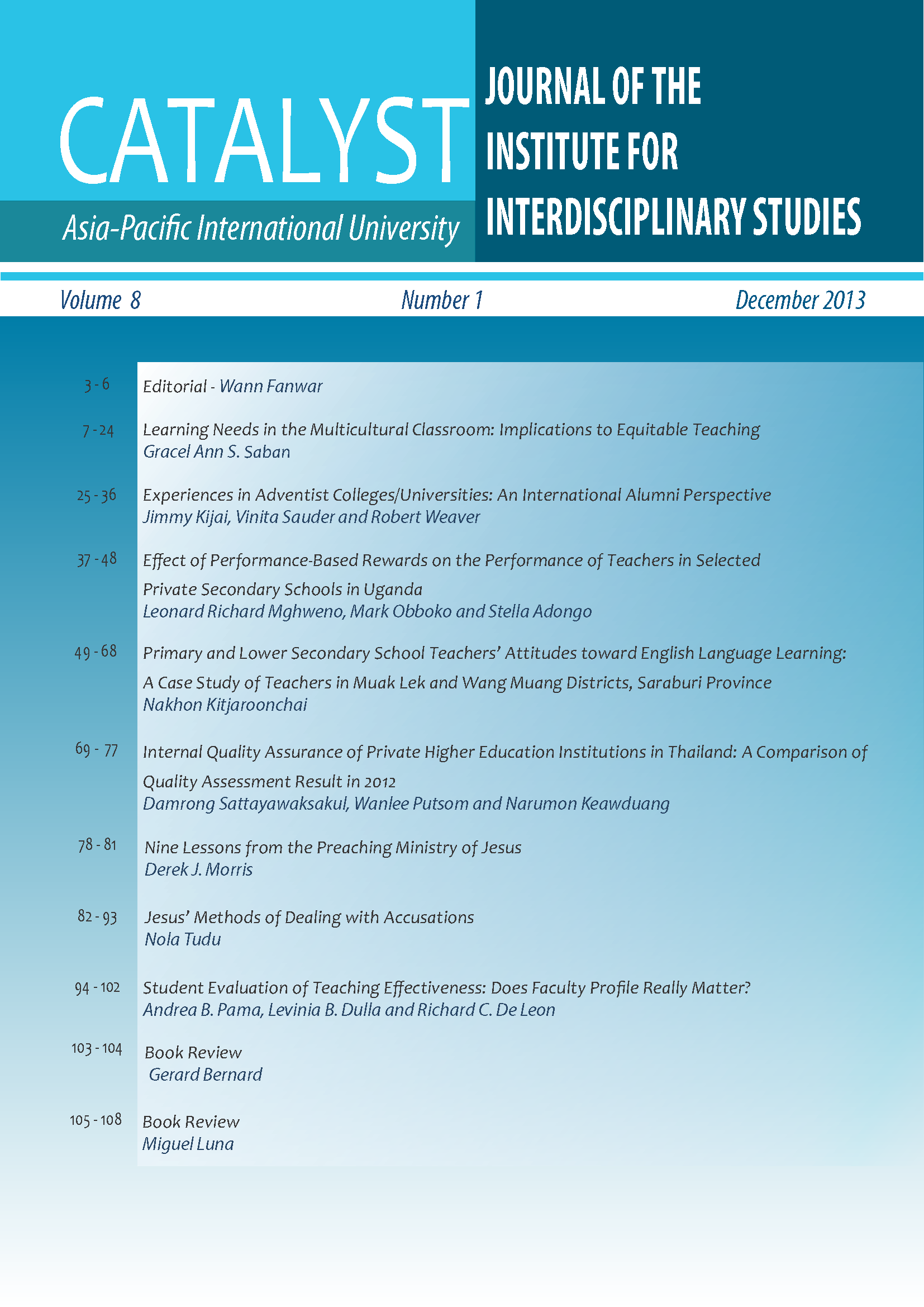Jesus’ Methods of Dealing with Accusations
Main Article Content
Abstract
One aspect of communication that affects people deeply is false accusations. This study intended to discover the method of communication Jesus used in dealing with false accusations. There is very little data showing Jesus’ methods of dealing with accusation. The book of Matthew was used as the source of data.
The data was analysed using content analysis with intercoder reliability of 0.4 percent. It was found that Jesus primarily responded to false accusation in six ways: by asking questions; by sharing parables, analogies, or maxims; by giving strong words of condemnation or affirmation; by referring to the scriptures; by withdrawing from the accusers; and by keeping silent. All these ways of communicating with people when accused falsely, follows a progression of behaviour from active engagement to a passive one.
Article Details

This work is licensed under a Creative Commons Attribution-NonCommercial-NoDerivatives 4.0 International License.
Copyright: Asia-Pacific International University reserve exclusive rights to publish, reproduce and distribute the manuscript and all contents therein.
References
Bennema, C. (2010, January-March). Was Jesus an effective communicator? Engage, 19-25, Retrieved from http://www.saiacs.org/Design/Downloads/BENNEMA-2010%20Engage%20RZIM-Was%20Jesus%20 an%20Effective%20Communicator.pdf
Bockmuehl, M. (2001). The Cambridge companion to Jesus. Cambridge: Cambridge University Press. Matthew 9- IVP New Testament Commentaries. http://www.biblegateway.com/resources/commentaries/IVP-NT/Matt/Jesus-Authority-Forgive-Sins
Burger, C. (2000, Fall). Jesus the communicator. Public Relations Quarterly, Vol. 45 (3), 29-31.
Chouinard, L. (1997). College Press NIV Commentary: Matthew. USA: College Press Publishing.
Clarke, A. (1950).Clarke’s Commentary. Vol. V. Matthew-Acts. New York: Abingdon-Cokesbury.
Danaher, J.P. (2011). Out of context—the Gospel according to Jesus. Evangelical Review of Theology (ERT), Vol. 35 (2), 265-275.
Griffin, E. (2009). A first look at communication theory. (7th ed.). Singapore: McGraw-Hill.
Gross, L. (2012). Fastening our seatbelts: Turning crisis into opportunity. Journal of Communication, 62 (6), 919–931. doi: 10.1111/j.1460-2466.2012.01679.x
Irving, J.A. (2011, Summer). Leadership reflection: A model for effective servant leadership practice: A Biblically-consistent and research-based approach to leadership. Journal of Biblical Perspectives in Leadership, Vol.3, (2), 118-128. Retrieved from http://www.regent.edu/acad/global/publications/ jbpl/vol3no2/JBPL_Vol3No2_Irving_pp118-128.pdf
Knight, G. R. (1994). The abundant life Bible amplifier: A practical guide to abundant Christian living in the book of Matthew. Boise, Idaho: Pacific Press Publishing Association.
Lee, H. (2013). Jesus’ teaching through discovery. The ICCTE Journal (A Journal of the International Christian Community for Teacher Education), Vol.1 (2). Retrieved from http://icctejournal.org/issues/v1i2/ v1i2-lee/
McNamara, J. & Lawrence, J. (2012, September). False allegations of adult crimes. FBI Law Enforcement Bulletin. Retrieved from http://www.fbi.gov/stats-services/publications/law-enforcement-bulletin/ september-2012/false-allegations-of-adult-crimes
Morris, S. (2010, November). False allegations. Inside Time: The National Newspaper for Prisoners. Retrieved from http://www.insidetime.org/articleview.asp?a=845
One in four teachers have had false allegations made against them by pupils or their parents. (2009, Oct 27). Mail Online. Retrieved from http://www.dailymail.co.uk/news/article-1222989/Half-teachers-falseallegations-pupils-parents.html
Pennington, J.T. (2009). Matthew 13 and the function of the parables in the first gospel. SBJT (Southern Baptist Journal of Theology), Vol. 13 (3), 12-20. Retrieved from http://www.sbts.edu/resources/files/2009/10/ sbjt_v13_n3_pennington.pdf
Rahim, A. (2002). Toward a theory of managing organizational conflict. The International Journal of Conflict Management, Vol. 13 (3), 206-235. Retrieved from http://www.negotiationlawblog.com/uploads/ file/Organizational%20Conflict.pdf
Sanders, E.P. (2013). Scribes and Pharisees. Encyclopaedia Britannica. Retrieved from http://global.britannica.com/EBchecked/topic/303091/Jesus-Christ/223003/Scribes-and- Pharisees Smith, M. (2007, Nov. 1). Smoke without fire: Social workers’ fears of threats and accusations. Journal of Social Work Practice, 21 (3), 323-335. DOI: 10.1080/02650530701553625.
Stallard, J. (2007, Fall). Responding to true and false accusations in the church. The Journal of Ministry of Theology, Vol. 11 (2), 119-135. Retrieved from http://www.bbc.edu/journal/volume11_2/ respondingto_accusations.pdf
Vledder, E.J. (1997). Conflict in the miracle stories: A socio-exegetical study of Matthew 8 and 9. Sheffield: Sheffield Academy Press. Retrieved from books.google.co.th/books?isbn=1850756996
White, E.G. (1991). Short stories for positive Christian living. Pune, India: Oriental Watchman Publishing House.


